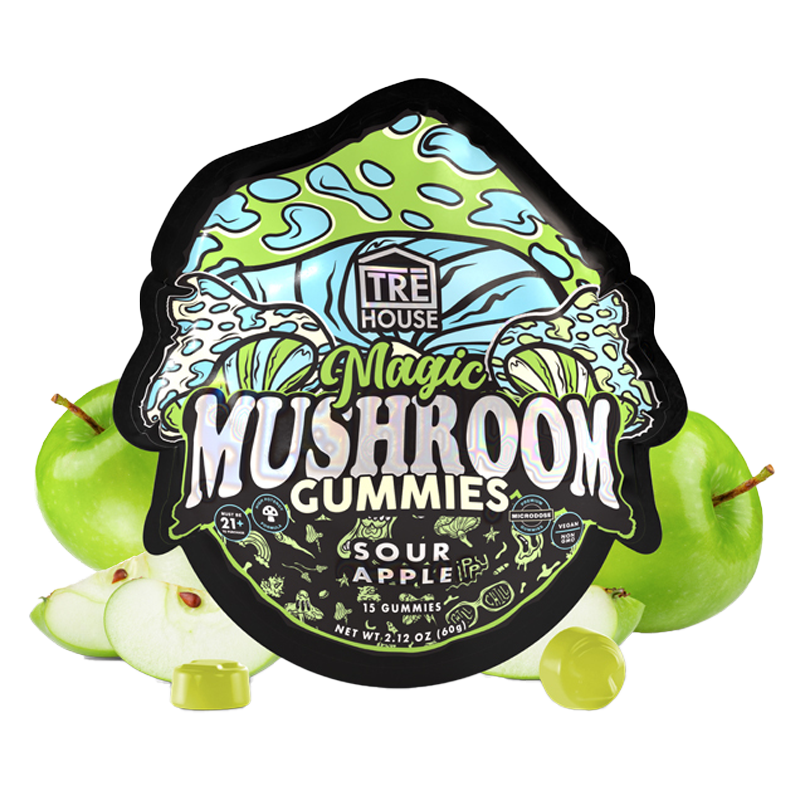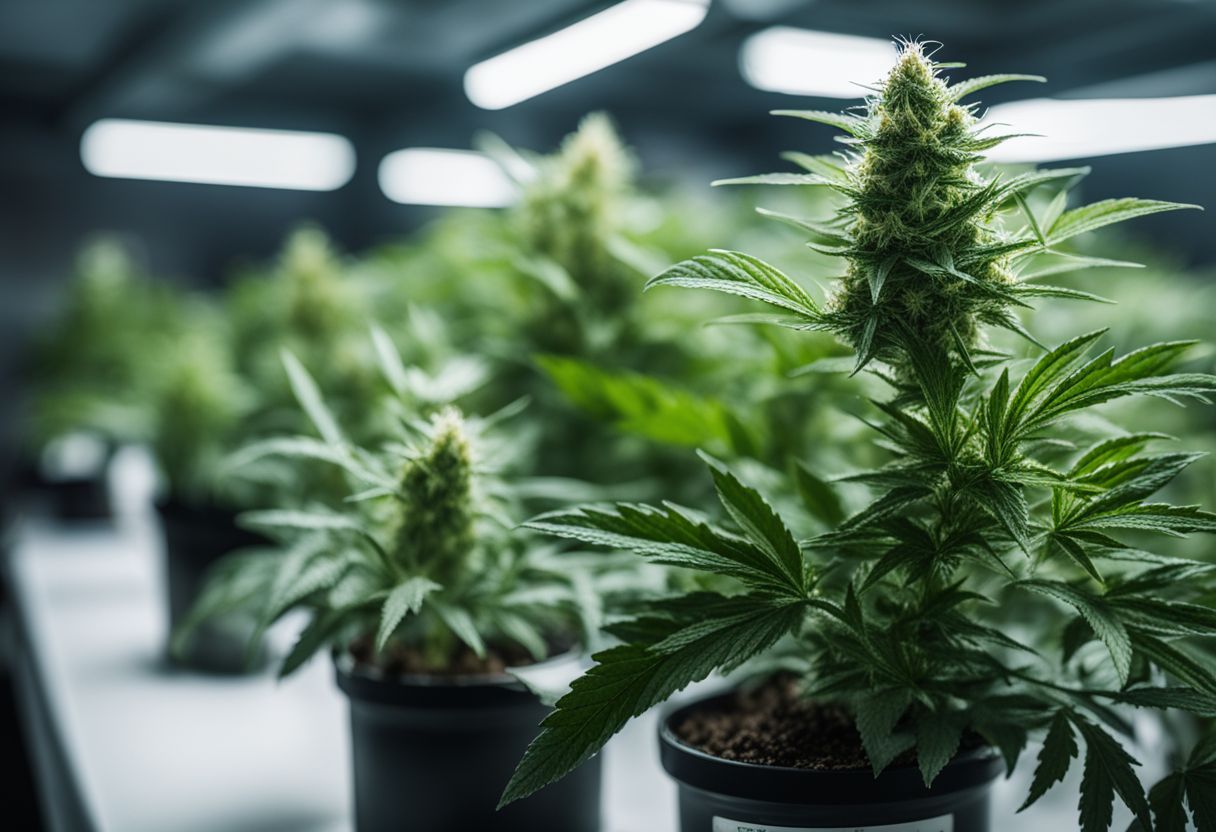Moving from the basic overview, let’s dive into CBG. It stands for cannabigerol, and it’s a compound found in cannabis plants. Think of it as a cousin to CBD and THC, which you might already know about.
But unlike THC, CBG won’t make you feel high—that’s because it’s not psychoactive.
CBG starts off as what scientists call cannabigerolic acid (CBGA) in the plant. As the plant grows, this changes into other cannabinoids like CBD and THC. Since CBG is made early in the plant’s growth cycle, there isn’t much left at harvest time.
That’s why we call it a minor cannabinoid – there’s less of it compared to some others but that doesn’t mean its effects aren’t powerful.
TRE House
<p>Sour Apple Mushroom Gummies: tasty, magical experiences. One for chill, more for party, even more for mystical journeys.</p>
Check Price
Differences Between CBG and CBD
When you’re exploring the world of cannabinoids beyond the well-known CBD, you’ll likely come across CBG, which is garnering interest for its unique potential. Understanding the distinctions between CBG and CBD is vital as you consider which may better suit your needs. Here’s a snapshot of their differences:
| Aspect | CBG (Cannabigerol) | CBD (Cannabidiol) |
|---|---|---|
| Occurrence in plants | Less abundant, often referred to as a minor cannabinoid | More abundant, one of the major cannabinoids |
| Psychoactivity | Non-psychoactive, does not produce a high | Non-psychoactive, does not produce a high |
| Research Status | Emerging research, less studied compared to CBD | More extensively researched, with a wide array of studies on its effects |
| Potential Benefits | Shows promise in treating conditions like glaucoma, inflammatory bowel disease, and anxiety | Widely recognized for its anti-inflammatory, anti-anxiety, and pain-relieving properties |
| Availability | Less commonly found in products due to lower occurrence in plants | Widely available in various forms such as oils, edibles, topicals, and capsules |
| Effect on Appetite | Potential to stimulate appetite | Generally considered to have little to no effect on appetite |
| Price | Typically more expensive due to the cost of production | More affordable due to its prevalence and established extraction methods |
Bear in mind, while both CBG and CBD offer therapeutic potential without the high associated with THC, they play different roles within the body, and their individual benefits should be considered when making your choice. With ongoing research, the full breadth of CBG’s applications continues to unfold.

The Therapeutic Benefits of CBG
CBG has shown promising therapeutic benefits such as anti-inflammatory properties, potential treatment for anxiety and depression, role in chronic pain management, use in inflammatory bowel disease (IBD), glaucoma treatment, and possible role in cancer treatment.
To learn more about the potential health benefits of CBG, continue reading the blog.
Anti-Inflammatory Properties
CBG might make things better if you have swelling in your body. This is because it works against inflammation. Imagine your joints or muscles are sore and swollen; CBG could help calm them down.
It’s like putting out a fire inside your body that can cause you pain or trouble moving around.
Scientists are looking closely at how CBG helps guts stay healthy too. If you have gut problems, like with Crohn’s disease, CBG might be something to consider. It may help reduce the swelling in your intestines, making it easier for you to eat and feel good again.
Potential Treatment for Anxiety and Depression
CBG, or cannabigerol, shows promise as a potential treatment for anxiety and depression. Research suggests that CBG may interact with the endocannabinoid system in the body to produce calming effects.
This interaction could help regulate mood, reduce feelings of stress, and alleviate symptoms of both anxiety and depression. Additionally, CBG’s anti-inflammatory properties might also play a role in reducing symptoms associated with these conditions by targeting inflammation in the body.
Furthermore, CBG is non-psychoactive and does not induce a “high” like THC. This means that individuals seeking relief from anxiety and depression may benefit from CBG without experiencing mind-altering effects.
Role in Chronic Pain Management
CBG, like CBD, may help manage chronic pain. Early research suggests that CBG interacts with the body’s endocannabinoid system to reduce inflammation and provide pain relief. The potential anti-inflammatory properties of CBG could offer a natural alternative for those seeking relief from chronic pain without the psychoactive effects of THC.
Ongoing studies are exploring how CBG can be used as a complementary approach to alleviate discomfort associated with various conditions.
Research into the therapeutic uses of cannabinoids is still in its early stages, and more comprehensive studies are needed to understand the full extent of CBG’s benefits for managing chronic pain effectively.
Use in Inflammatory Bowel Disease (IBD)
Moving from chronic pain management to potential benefits in inflammatory bowel disease, it’s essential to consider the promising role of CBG. Research indicates that CBG may have anti-inflammatory effects, which could be beneficial for individuals with IBD.
The ability of CBG to reduce inflammation in the gut may offer a new avenue for managing symptoms associated with ulcerative colitis and other forms of IBD. Additionally, its potential role in improving gut health aligns with the ongoing studies exploring its therapeutic benefits for gastrointestinal conditions.
As you continue your exploration of CBG and its potential impact on health and wellness, it’s important to stay informed about the latest research developments related to its use in managing inflammatory bowel disease.
Potential Use in Glaucoma Treatment
With its potential benefits for treating inflammatory bowel disease, CBG also shows promise as a treatment for glaucoma. Glaucoma is a condition that increases pressure within the eye, which can lead to optic nerve damage and vision loss.
Studies suggest that CBG may help in reducing intraocular pressure (IOP), potentially providing relief for individuals with glaucoma. While more research is needed to fully understand how CBG can be used to manage this condition, the early findings are encouraging.
Glaucoma affects millions of people worldwide and discovering effective treatments is crucial. The possible use of CBG in managing intraocular pressure provides hope for those seeking alternative approaches to traditional glaucoma treatments.
Possible Role in Huntington’s Disease Treatment
In addition to its potential use in glaucoma treatment, CBG also shows promise as a possible treatment for Huntington’s disease. Research suggests that CBG may have neuroprotective effects which could be beneficial for individuals with this neurodegenerative condition.
Studies have indicated that CBG might help protect the nerve cells in the brain from degeneration, potentially slowing down the progression of Huntington’s disease. While further research is needed to fully understand the impact of CBG on this condition, these early findings present an intriguing possibility for those affected by Huntington’s disease.
The preliminary evidence of CBG’s neuroprotective effects makes it an area worth exploring further, particularly in relation to conditions like Huntington’s disease where there is currently no cure.
Potential Role in Cancer Treatment
Continuing from the potential use of CBG in Huntington’s disease treatment, research suggests that CBG may have a potential role in cancer treatment. Studies have shown that CBG could inhibit the growth of certain types of cancer cells, such as colon cancer cells.
Additionally, it has displayed anti-tumor properties and may induce programmed cell death in tumor cells. These early findings indicate the possibility of CBG being explored further for its potential anti-cancer effects.
As research progresses, understanding how CBG affects different types of cancers and its interaction with other treatments will be crucial for determining its practical application in cancer care.
Use in Bacterial Infections
After exploring CBG’s potential role in cancer treatment, it’s essential to note its promising use in bacterial infections. Research suggests that CBG may have antimicrobial properties, which could make it effective against various types of bacteria, including Staphylococcus aureus.
This is significant as antibiotic resistance is a growing concern globally. Studies indicate that CBG has shown potential in combating certain strains of Staphylococcus aureus, offering hope for future treatments against bacterial infections.
While more research is needed to fully understand its effectiveness, these findings highlight the exciting potential of CBG in addressing antibiotic-resistant bacterial infections and promoting overall health.
How CBG Works
CBG works by interacting with the body’s cannabinoid receptors, influencing various physiological functions. To learn more about how CBG affects the endocannabinoid system and its potential therapeutic benefits, continue reading below.
Cannabinoid Receptors in the Body
Cannabinoid receptors are like little locks scattered throughout your body, waiting for the right key to unlock their potential. These receptors play a crucial role in various bodily functions such as mood, pain sensation, and even appetite regulation.
There are two main types of cannabinoid receptors: CB1 and CB2. CB1 is primarily found in the brain and nervous system, while CB2 is more prevalent in the immune system and peripheral organs.
When activated by cannabinoids like CBG, these receptors can influence how you feel pain, manage stress, or regulate inflammation.
CBG interacts with these cannabinoid receptors in your body to potentially produce therapeutic effects without causing a “high.” The activation of these receptors can affect neurotransmitters in your brain and modulate immune responses elsewhere in the body.
How CBG is Consumed
You can consume CBG in several ways. Here’s how:
- CBG oil: Similar to CBD oil, CBG oil is available for sublingual administration or adding to food and beverages.
- CBG capsules: Encapsulated CBG doses offer a convenient and controlled way of consumption.
- CBG edibles: You can find gummies, chocolates, and other edibles infused with measured doses of CBG.
- CBG topicals: Creams, lotions, and balms containing CBG can be applied directly to the skin for localized effects.
- CBG vapes: Vaping CBG cartridges or concentrates allows for quick absorption into the bloodstream.
- CBG tinctures: These alcohol-based extracts offer another method for consuming precise doses of CBG.
Side Effects and Risks of CBG
CBG may cause side effects like dizziness, dry mouth, and low blood pressure. Here are potential risks of using CBG:
- Drowsiness: High doses of CBG might make you feel sleepy.
- Interaction with Medications: CBG can interact with certain medications, so consult a healthcare professional before use.
- Lack of Regulation: Quality and safety standards for CBG products are not well-established.
- Limited Research: More research is needed to understand the long-term effects and potential risks of CBG use.
- Allergic Reactions: Some people may have allergic reactions to CBG products.
Comparing the Legal Status of CBD, CBG, and THC
Navigating the murky waters of cannabinoid legality can be confusing, so let’s clarify how CBD, CBG, and THC compare in terms of their legal status. Remember, regulations can vary widely by country and even within regions of a country, especially in the United States. Here’s a snapshot to help you understand where these cannabinoids stand:
| Cannabinoid | Legal Status | Key Notes |
|---|---|---|
| CBD (Cannabidiol) | Federally legal in the U.S., with restrictions | Must be derived from hemp with less than 0.3% THC; varies internationally |
| CBG (Cannabigerol) | Federally legal in the U.S., with restrictions | Similar to CBD; must come from hemp with THC under 0.3% |
| THC (Tetrahydrocannabinol) | Federally illegal in the U.S.; some states have legalized medical or recreational use | Psychoactive component of cannabis; legality varies widely |
Legal considerations play a crucial role when you’re exploring cannabinoid options. You’ll find that CBD and CBG, derived from hemp, are generally legal, provided they contain negligible THC content. Unlike its non-psychoactive counterparts, THC’s legal status is less straightforward due to its intoxicating effects. Always stay updated with the latest regulations in your area to ensure you make informed decisions.
Safety Considerations when Taking CBD and CBG Simultaneously
Always consult with a healthcare professional before combining CBD and CBG. Research on their potential interactions is still ongoing. Both compounds may affect certain enzymes in the liver that are responsible for metabolizing medications, which could potentially lead to adverse effects or decreased effectiveness of other medications you may be taking.
Additionally, remember that while CBG is not psychoactive like THC, it can still cause side effects such as drowsiness or changes in appetite when taken in high doses. Therefore, it’s crucial to start with low doses and gradually increase while monitoring how your body responds.
The Prospects of CBG in Medical Research
CBG shows promising potential in medical research, with studies indicating its anti-tumor activity, neuroprotective effects, and potential for treating anxiety and nausea. To learn more about the exciting possibilities of CBG in the field of medical research, continue reading our blog.
Anti-Tumor Activity
CBG, a compound found in cannabis, shows potential in fighting tumors. Research suggests that CBG may inhibit the growth of cancer cells and promote cancer cell death. It is believed to achieve this by targeting specific receptors involved in tumor growth and development.
Additionally, CBG has shown promise in reducing inflammation associated with cancer, which can contribute to its potential anti-tumor activity.
The early studies suggest that CBG might be beneficial for different types of cancers such as colon carcinogenesis and brain cancer. However, it’s important to note that more extensive research is needed to fully understand how CBG can be utilized effectively as part of cancer treatment.
Neuroprotective Effects
As we explore the potential benefits of CBG, it’s essential to consider its neuroprotective effects. Research suggests that CBG may offer protective properties for the nervous system.
Studies have indicated that CBG shows promise in providing support against neurodegeneration and may help in protecting brain cells from damage. Additionally, there is ongoing research into how CBG could potentially aid in conditions related to neuroinflammation, apoptosis, and neurotoxins.
The findings indicate that CBG has shown anti-apoptotic and anti-inflammatory properties which could play a crucial role in protecting the central nervous system. Moreover, with its potential to protect nerve cells from damage and degeneration, there is growing interest in exploring how CBG can contribute to maintaining optimal neurological function.
Anti-Anxiety Effects
CBG may have anti-anxiety effects, which means it could help you feel calmer and more relaxed. Research suggests that CBG interacts with your brain’s receptors to potentially reduce anxiety and stress.
It’s important to note that while early studies show promise, more research is needed to fully understand how CBG can specifically help with anxiety. Also, CBG does not produce the psychoactive effects associated with THC, so it won’t make you feel high or alter your mental state like marijuana might.
Remember that everyone reacts differently to supplements, so if you’re considering trying CBG for its potential anti-anxiety benefits, speak with a healthcare professional first. They can provide guidance based on your individual health needs and any other medications you may be taking.
Anti-Nausea Effects
CBG may help reduce nausea and vomiting due to its interaction with the body’s endocannabinoid system. This can be particularly beneficial for individuals undergoing chemotherapy or experiencing nausea from other medical conditions.
Research suggests that CBG, along with other cannabinoids, may have anti-nausea properties, potentially offering relief for those struggling with these symptoms. However, more thorough research is needed to fully comprehend the extent of CBG’s anti-nausea effects in various contexts.
These potential anti-nausea effects of CBG are part of ongoing studies exploring the broad spectrum of benefits associated with cannabinoid compounds. These studies aim to provide a better understanding of how CBG interacts with the body’s systems and its potential therapeutic applications.
Reduction in Intraocular Pressure (IOP)
As we transition from discussing the potential anti-nausea effects of CBG, it’s worth noting that research suggests CBG may also play a role in reducing intraocular pressure (IOP).
This is particularly significant in relation to glaucoma, a condition where elevated IOP can lead to optic nerve damage and vision loss. Studies have indicated that CBG has the potential to reduce IOP, which could be valuable in exploring alternative treatments for glaucoma.
With ongoing research into the therapeutic benefits of CBG, its potential in managing conditions like glaucoma is an area of great interest.
Early studies suggest that one notable effect of CBG is its ability to lower intraocular pressure. Given the association between elevated IOP and conditions such as glaucoma, this finding holds promise for future treatment possibilities.
Effects on Skin
Research suggests that CBG may have potential benefits for your skin. Studies indicate that CBG could help in managing conditions like psoriasis and eczema due to its anti-inflammatory properties.
The cannabinoid also shows promise in regulating the skin’s sebum production, potentially aiding in controlling acne. Furthermore, CBG may contribute to promoting overall skin health by acting as an antioxidant, helping to combat free radicals and reduce signs of aging.
Regarding safety, it’s important to note that while research is still ongoing on the effects of CBG on the skin, early findings are promising. However, individuals with sensitive skin or existing dermatological conditions should approach using topical CBG products cautiously until further evidence is available.
Conclusion
In conclusion, exploring CBG reveals potential benefits for managing chronic pain, anxiety, and gut health. As research on CBG is in its early stages, further studies are needed to fully understand its effects and risks.
Despite being a minor cannabinoid, CBG shows promise in therapeutic applications such as glaucoma treatment. While ongoing research continues to uncover the potential of CBG for health and wellness, it’s crucial to await more robust evidence before drawing definitive conclusions about its efficacy and safety.
If you’re interested in understanding more about cannabinoids, delve into the distinctions between CBD and THC here.
FAQs
1. What is CBG?
CBG, or cannabigerol, is a plant-based cannabinoid found in cannabis sativa plants, similar to well-known compounds like THC (tetrahydrocannabinol) and CBD (cannabidiol).
2. How does CBG work in the body?
CBG works by interacting with our body’s endocannabinoids and binding to CB2 receptors which can affect many bodily functions.
3. Can CBG help people with certain health problems?
Yes, studies suggest that CBG might help with issues like multiple sclerosis, seizures from conditions like epilepsy, and IBS (irritable bowel syndrome), but more research is needed.
4. Does taking CBG have any risks?
There may be risks because the Food and Drug Administration (FDA) doesn’t regulate all cannabis-derived products tightly; also smoking strains of cannabis can lead to marijuana addiction or other issues.
5. Do doctors use CBG in treatments now?
Some doctors might consider it for neuroprotection or anti-glaucoma properties based on early studies, but it’s not widely accepted for official medical treatment yet.
6. Is there more than one kind of effect from using CBG?
Yes! While some effects are helpful for things like neurogenesis and reducing inflammation, others need caution due to less known pharmacokinetic details and possible psychotropic effects.






